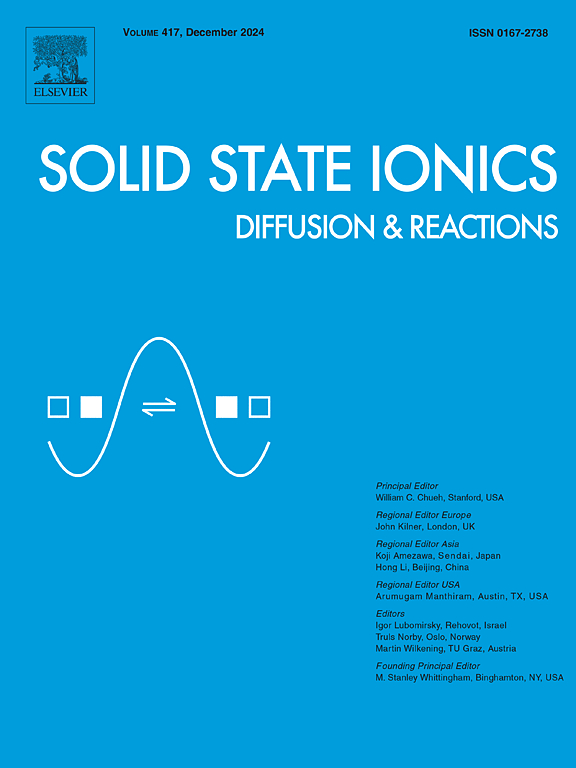三导电氧化物BaCo0.4Fe0.4Zr0.1Y0.1O3-δ (BCFZY4411)的热力学、局域结构和质子输运
IF 3.3
4区 材料科学
Q3 CHEMISTRY, PHYSICAL
引用次数: 0
摘要
三导电氧化物(TCOs)是一类新兴的混合离子和电子导电材料,在氧还原/析氧(ORR/OER)电催化方面表现出很大的前景,主要用于高温陶瓷电化学电池,但也用于碱性水环境。它们的高活性至少部分归因于它们能够结合和传输三种移动电荷载体:质子、氧空位和电子空穴。尽管它们很有前景,但tco的基础研究仍然具有挑战性,因为三个载流子的输运动力学不能通过传统的电测量技术完全解开。表征tco中的质子动力学是特别困难的,因为质子通常是少数载流子,它们的传导响应通常被氧空位和电子空穴所掩盖。在这里,我们展示了成功地分离质子行为的原型TCO, BaCo0.4Fe0.4Zr0.1Y0.1O3-δ (BCFZY4411),使用非电技术的组合。我们用热重分析(TGA)测定质子摄取和氧非化学计量(δ)。利用x射线吸收近边结构(XANES)和中子衍射(ND)验证了Co的氧化态和TGA所得的δ值。我们应用1H固态魔角旋转(MAS)核磁共振(NMR)来提供对局部结构、动力学和质子动力学的见解。最后,利用示踪同位素交换和飞行时间二次离子质谱(ToF-SIMS)进一步量化质子输运性质。尽管BCFZY4411中的质子浓度非常低(在大多数条件下为0.2%),但我们的分析表明,氧还原和析出反应仍然受到氧离子动力学(例如氧表面交换)的限制,而不是电化学电池应用的降低操作温度(<500°C)下的质子动力学。这些发现为BCFZY4411的质子行为提供了全面的认识,并为推进tco的基础研究铺平了道路。本文章由计算机程序翻译,如有差异,请以英文原文为准。
Thermodynamics, local structure, and transport of protons in triple-conducing oxide, BaCo0.4Fe0.4Zr0.1Y0.1O3-δ (BCFZY4411)
Triple-conducting oxides (TCOs) are an emerging class of mixed ionic and electronically conducting materials that show great promise for oxygen reduction/evolution (ORR/OER) electrocatalysis—primarily in high-temperature ceramic electrochemical cells— but also in aqueous alkaline environments. Their high activity is attributed, at least in part, to their ability to incorporate and transport three mobile charge carriers: protons, oxygen vacancies, and electron-holes. Despite their promise, fundamental studies of TCOs are challenging, as transport dynamics from three charge carriers cannot be fully disentangled via traditional electrical measurement techniques. Characterizing proton dynamics in TCOs is particularly difficult as protons are generally the minority carrier, and their conduction response is typically obscured by the oxygen vacancies and electron holes. Here, we demonstrate successful isolation of the proton behavior in an archetypal TCO, BaCo0.4Fe0.4Zr0.1Y0.1O3-δ (BCFZY4411), using a combination of non-electrical techniques. We determine proton uptake and oxygen non-stoichiometry (δ) using thermogravimetric analysis (TGA). X-ray absorption near edge structure (XANES) and neutron diffraction (ND) are used to validate the oxidation state of Co and the δ values obtained through TGA. We apply 1H solid-state magic-angle-spinning (MAS) nuclear magnetic resonance (NMR) to provide insights into local structure, dynamics, and proton kinetics. Finally, the proton transport properties are further quantified using tracer isotope exchange with time-of-flight secondary ion mass spectrometry (ToF-SIMS). Despite the very low proton concentrations in BCFZY4411 (<0.2 % under most conditions), our analysis suggests that the oxygen reduction and evolution reactions are nevertheless limited by the oxygen ion kinetics (e.g., oxygen surface exchange) rather than the proton kinetics at the reduced operating temperatures (<500 °C) that are targeted for electrochemical cell applications. These findings provide a comprehensive understanding of proton behavior in BCFZY4411 and pave the way for advancing the fundamental study of TCOs.
求助全文
通过发布文献求助,成功后即可免费获取论文全文。
去求助
来源期刊

Solid State Ionics
物理-物理:凝聚态物理
CiteScore
6.10
自引率
3.10%
发文量
152
审稿时长
58 days
期刊介绍:
This interdisciplinary journal is devoted to the physics, chemistry and materials science of diffusion, mass transport, and reactivity of solids. The major part of each issue is devoted to articles on:
(i) physics and chemistry of defects in solids;
(ii) reactions in and on solids, e.g. intercalation, corrosion, oxidation, sintering;
(iii) ion transport measurements, mechanisms and theory;
(iv) solid state electrochemistry;
(v) ionically-electronically mixed conducting solids.
Related technological applications are also included, provided their characteristics are interpreted in terms of the basic solid state properties.
Review papers and relevant symposium proceedings are welcome.
 求助内容:
求助内容: 应助结果提醒方式:
应助结果提醒方式:


